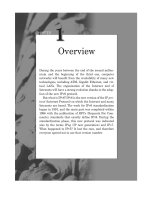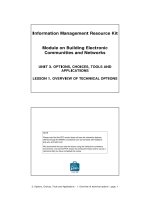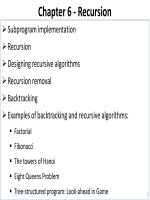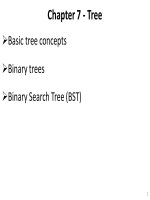Lecture Data security and encryption - Chapter 1: Overview
Bạn đang xem bản rút gọn của tài liệu. Xem và tải ngay bản đầy đủ của tài liệu tại đây (698.26 KB, 80 trang )
Data Security and Encryption
(CSE348)
1
Dr. Basit Raza
Assistant Professor
Comsats Institute of Information
Technology, Islamabad
2
Course Outline
In this course we will follow the mentioned book
Cryptography and Network Security”,
5th Edition by William Stallings.
The book is organized into seven parts:
3
Course Outline
Part One: Symmetric Ciphers:
Provides a survey of symmetric encryption,
including classical and modern algorithms. The
emphasis is on the two most important algorithms,
the Data Encryption Standard (DES) and the
Advanced Encryption Standard (AES).This part
also covers the most important stream encryption
algorithm,RC4,and the important topic of
pseudorandom number generation.
4
Course Outline
Part Two: Asymmetric Ciphers:
Provides a survey of publickey algorithms,
including RSA (RivestShamirAdelman) and
elliptic curve.
5
Course Outline
Part Three: Cryptographic Data Integrity
Algorithms:
Begins with a survey of cryptographic
hash functions. This part then covers two
approaches to data integrity that rely on
cryptographic hash functions: message
authentication codes and digital signatures.
6
Course Outline
Part Four: Mutual Trust:
Covers key management and key distribution
topics and then covers user authentication
techniques.
7
Course Outline
Part Five: Network Security and Internet
Security:
Examines the use of cryptographic
algorithms and security protocols to provide
security over networks and the Internet. Topics
covered include transportlevel security, wireless
network security, email security, and IP security.
8
Course Outline
Part Six: System Security:
Deals with security facilities designed to protect a
computer system from security threats, including
intruders, viruses, and worms. This part also looks
at firewall technology.
9
Course Outline
Part Seven: Legal and Ethical Issues:
Deals with the legal and ethical issues related
to computer and network security.
10
Course Outline
Chapter 1 Overview
1.1 Computer Security Concepts
1.2 The OSI Security Architecture
1.3 Security Attacks
1.4 Security Services
1.5 Security Mechanisms
1.6 A Model for Network Security
1.7 Recommended Reading and Web Sites
1.8 Key Terms and Review Questions
11
Course Outline
PART ONE SYMMETRIC CIPHERS
Chapter 2 Classical Encryption Techniques
2.1 Symmetric Cipher Model
2.2 Substitution Techniques
2.3 Transposition Techniques
2.4 Rotor Machines
2.5 Steganography
2.6 Recommended Reading and Web Sites
2.7 Key Terms and Review Questions
12
Course Outline
Chapter 3 Block Ciphers and the Data Encryption
Standard
3.1 Block Cipher Principles
3.2 The Data Encryption Standard (DES)
3.3 A DES Example
3.4 The Strength of DES
3.5 Differential and Linear Cryptanalysis
3.6 Block Cipher Design Principles
3.7 Recommended Reading and Web Site
3.8 Key Terms and Review Questions
13
Course Outline
Chapter 4 Basic Concepts in Number Theory and
Finite Fields
4.1 Divisibility and the Division Algorithm
4.2 The Euclidean Algorithm
4.3 Modular Arithmetic
4.4 Groups, Rings, and Fields
4.5 Finite Fields of the Form GF(p)
4.6 Polynomial Arithmetic
4.7 Finite Fields of the Form GF(2n)
4.8 Recommended Reading and Web Sites
4.9 Key Terms and Review Questions
14
Course Outline
Chapter 5 Advanced Encryption Standard
5.1 The Origins AES
5.2 AES Structure
5.3 AES Round Functions
5.4 AES Key Expansion
5.5 An AES Example
5.6 AES Implementation
5.7 Recommended Reading and Web Sites
5.8 Key Terms and Review Questions
15
Course Outline
Chapter 6 Block Cipher Operation
6.1 Multiple Encryption and Triple DES
6.2 Electronic Codebook Mode
6.3 Cipher Block Chaining Mode
6.4 Cipher Feedback Mode
6.5 Output Feedback Mode
6.6 Counter Mode
6.7 XTS Mode for Block-Oriented Storage Devices
6.8 Recommended Web Site
6.9 Key Terms and Review Questions
16
Course Outline
Chapter 7 Pseudorandom Number Generation and
Stream Ciphers
7.1 Principles of Pseudorandom Number Generation
7.2 Pseudorandom Number Generators
7.3 Pseudorandom Number Generation Using a Block
Cipher
7.4 Stream Ciphers
7.5 RC4
7.6 True Random Numbers
7.7 Recommended Reading
7.8 Key Terms and Review Questions
17
Course Outline
PART TWO ASYMMETRIC CIPHERS
Chapter 8 More Number Theory
8.1 Prime Numbers
8.2 Fermat’s and Euler’s Theorems
8.3 Testing for Primality
8.4 The Chinese Remainder Theorem
8.5 Discrete Logarithms
8.6 Recommended Reading and Web Sites
8.7 Key Terms and Review Questions
18
Course Outline
Chapter 9 Public-Key Cryptography and RSA
9.1 Principles of Public-Key Cryptosystems
9.2 The RSA Algorithm
9.3 Recommended Reading and Web Sites
9.4 Key Terms and Review Questions
19
Course Outline
Chapter 10 Other Public-Key Cryptosystems
10.1 Diffie-Hellman Key Exchange
10.2 ElGamal Cryptosystem
10.3 Elliptic Curve Arithmetic
10.4 Elliptic Curve Cryptography
10.5 Pseudorandom Number Generation Based on an
Asymmetric Cipher
10.6 Recommended Reading and Web Sites
10.7 Key Terms and Review Questions
20
Course Outline
PART THREE CRYPTOGRAPHIC DATA
INTEGRITY ALGORITHMS
Chapter 11 Cryptographic Hash Functions
11.1 Applications of Cryptographic Hash Functions
11.2 Two Simple Hash Functions
11.3 Requirements and Security
11.4 Hash Functions Based on Cipher Block Chaining
11.5 Secure Hash Algorithm (SHA)
11.6 SHA-3
11.7 Recommended Reading and Web Sites
11.8 Key Terms and Review Questions
21
Course Outline
Chapter 12 Message Authentication Codes
12.1 Message Authentication Requirements
12.2 Message Authentication Functions
12.3 Message Authentication Codes
12.4 Security of MACs
12.5 MACs Based on Hash Functions:HMAC
12.6 MACs Based on Block Ciphers: DAA and CMAC
12.7 Authenticated Encryption: CCM and GCM
12.8 Pseudorandom Number Generation Using Hash
Functions and MACs
12.9 Recommended Reading
12.10 Key Terms and Review Questions
22
Course Outline
Chapter 13 Digital Signatures
13.1 Digital Signatures
13.2 ElGamal Digital Signature Scheme
13.3 Schnorr Digital Signature Scheme
13.4 Digital Signature Standard (DSS)
13.5 Recommended Reading and Web Sites
13.6 Key Terms and Review Questions
23
Course Outline
PART FOUR MUTUAL TRUST
Chapter 14 Key Management and Distribution
14.1 Symmetric Key Distribution Using Symmetric
Encryption
14.2 Symmetric Key Distribution Using Asymmetric
Encryption
14.3 Distribution of Public Keys
14.4 X.509 Certificates
14.5 Public Key Infrastructure
14.6 Recommended Reading and Web Sites
14.7 Key Terms and Review Questions
24
Course Outline
Chapter 15 User Authentication Protocols
15.1 Remote User Authentication Principles
15.2 Remote User Authentication Using Symmetric
Encryption
15.3 Kerberos
15.4 Remote User Authentication Using Asymmetric
Encryption
15.5 Federated Identity Management
15.6 Recommended Reading and Web Sites
15.7 Key Terms and Review Questions
25









